
At 7.30 am this morning (15 August), Prime Minister Narendra Modi hoisted the Tricolour at the Red Fort and delivered his tenth Independence Day speech, equalling the record held by his predecessor – Manmohan Singh. On the 77th Independence Day, Modi in his 90-minute long address – this is his third-longest I-Day speech – set the tone for the 2024 general elections and continued his focus on the youth, women, farmers, and the small and medium sector. He stressed on the achievements during his term, and reiterated that India must be a developed nation by 2047, when we celebrate 100 years of Independence. Continuing his turban tales, he appeared passionate and full of enthusiasm at the historic
Red Fort
, saying there are no “ifs or buts” in the minds of the Indians and the world about India’s strength and potential and that the country’s developmental approach should keep in mind the global welfare as well. Through his several I-Day speeches – he’s only behind Jawaharlal Nehru and Indira Gandhi in addressing the nation on this day – the PM has articulated a wide range of ideas. Let’s take a closer look at them and how his last speech in the second term measures to the older ones. [caption id=“attachment_13000872” align=“alignnone” width=“640”]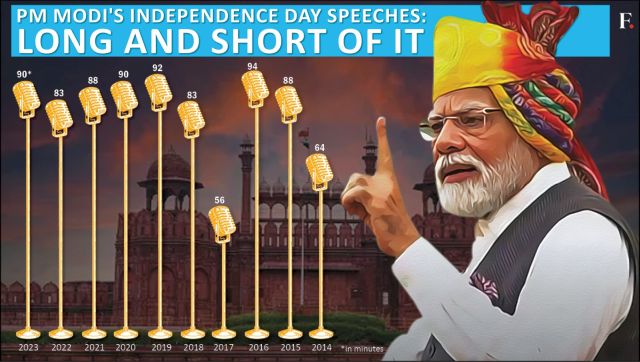 Graphic: Pranay Bhardwaj[/caption] I’ll be back speech (2023) As PM Modi spoke of India now being identified as a “Vishwa Mitra”, perhaps the biggest difference in the
speech
was that he addressed the nation as his “parivaarjan” (family members) rather than referring them as “my fellow citizens” in his previous speeches. Modi used the word “parivaarjan” at least 50 times in his nearly 90-minute-long speech, a point that many pundits pointed out soon after he concluded his address. In his speech, he covered a gamut of topics – from the violence in Manipur to how the nation was slowly transforming. The prime minister vowed that India would be among the top three economies in the world in the next five years and also announced the launch of some new schemes, including the
Vishwakarma Yojana
. Modi also identified “corruption, dynasty and appeasement politics” as three problems confronting India and exhorted people to rise against them. Taking on the Congress, he said in his speech, “How can a political party have only one family in charge? For them their life mantra is —party of the family, by the family and for the family.” In conclusion of his speech, Modi also had an Arnold Schwarzenegger moment when he said that he would present the
country’s achievements on 15 August 2024
. “The next five years are for unprecedented development. The biggest golden moment to realise the dream of 2047 is the next five years. The next time, on 15 August, I will present before you the achievements and developments of the country from this Red Fort,” he said during his Independence Day address. This is the second time he has alluded to the BJP’s victory in the upcoming Lok Sabha polls. Last week while replying to the no-confidence motion against him, he had said to the Opposition, “The country believes that in 2028 when you will bring a no-confidence motion, we will be among the top three economies globally, this is our belief.” [caption id=“attachment_13000922” align=“alignnone” width=“640”]
Graphic: Pranay Bhardwaj[/caption] I’ll be back speech (2023) As PM Modi spoke of India now being identified as a “Vishwa Mitra”, perhaps the biggest difference in the
speech
was that he addressed the nation as his “parivaarjan” (family members) rather than referring them as “my fellow citizens” in his previous speeches. Modi used the word “parivaarjan” at least 50 times in his nearly 90-minute-long speech, a point that many pundits pointed out soon after he concluded his address. In his speech, he covered a gamut of topics – from the violence in Manipur to how the nation was slowly transforming. The prime minister vowed that India would be among the top three economies in the world in the next five years and also announced the launch of some new schemes, including the
Vishwakarma Yojana
. Modi also identified “corruption, dynasty and appeasement politics” as three problems confronting India and exhorted people to rise against them. Taking on the Congress, he said in his speech, “How can a political party have only one family in charge? For them their life mantra is —party of the family, by the family and for the family.” In conclusion of his speech, Modi also had an Arnold Schwarzenegger moment when he said that he would present the
country’s achievements on 15 August 2024
. “The next five years are for unprecedented development. The biggest golden moment to realise the dream of 2047 is the next five years. The next time, on 15 August, I will present before you the achievements and developments of the country from this Red Fort,” he said during his Independence Day address. This is the second time he has alluded to the BJP’s victory in the upcoming Lok Sabha polls. Last week while replying to the no-confidence motion against him, he had said to the Opposition, “The country believes that in 2028 when you will bring a no-confidence motion, we will be among the top three economies globally, this is our belief.” [caption id=“attachment_13000922” align=“alignnone” width=“640”]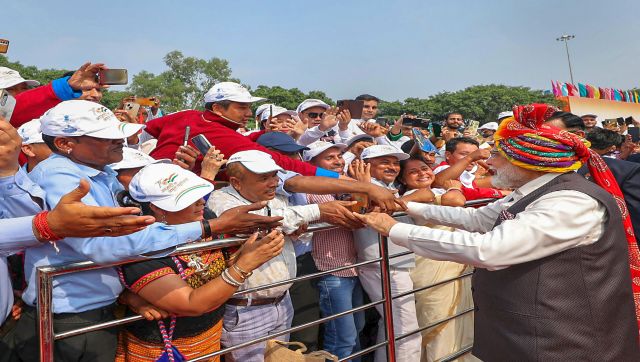 Prime Minister Narendra Modi greets visitors during the 77th Independence Day function at the historic Red Fort, in New Delhi. PTI[/caption] Panch Pran for Amrit Kaal (2022) Last year, in his ninth address to the country on Independence Day, PM Modi had laid down five resolves or the ‘panch pran’ for the ‘Amrit Kaal’. This included the pledge to work towards a ‘Viksit Bharat’ (developed India), remove any vestiges of colonialism, retain our roots, ensure unity in diversity, and carry out a citizen’s duties. He also took on corruption and dynastic politics in his speech, saying they were the biggest challenges for the nation. Furthermore, he took on China, without naming them, saying that those who challenge the country’s sovereignty, be it the Line of Control or Line of Actual Control, have been given a befitting reply in their own language. Vision for Amrit Kaal (2021) In 2021, PM Modi focused on next generation infrastructure that would help build a new India by 2047 – the 100th year of Independence. It was the year that he announced the Prime Minister Gati Shakti national master plan that expedites key projects and ensures that the stakeholders don’t work in silos. Laying out a blueprint of India’s development journey, he said: ‘Sabka Saath, Sabka Vikas, Sabka Vishwas and Sabka Prayaas’ is very important for the achievement of all our goals.” He further added, “We have to ensure we meet our goal of building Aatmanirbhar Bharat when we celebrate 100 years of India’s Independence.” He also announced the National Hydrogen Mission aimed at making India a global hub for Green Hydrogen production and export. [caption id=“attachment_13000962” align=“alignnone” width=“640”]
Prime Minister Narendra Modi greets visitors during the 77th Independence Day function at the historic Red Fort, in New Delhi. PTI[/caption] Panch Pran for Amrit Kaal (2022) Last year, in his ninth address to the country on Independence Day, PM Modi had laid down five resolves or the ‘panch pran’ for the ‘Amrit Kaal’. This included the pledge to work towards a ‘Viksit Bharat’ (developed India), remove any vestiges of colonialism, retain our roots, ensure unity in diversity, and carry out a citizen’s duties. He also took on corruption and dynastic politics in his speech, saying they were the biggest challenges for the nation. Furthermore, he took on China, without naming them, saying that those who challenge the country’s sovereignty, be it the Line of Control or Line of Actual Control, have been given a befitting reply in their own language. Vision for Amrit Kaal (2021) In 2021, PM Modi focused on next generation infrastructure that would help build a new India by 2047 – the 100th year of Independence. It was the year that he announced the Prime Minister Gati Shakti national master plan that expedites key projects and ensures that the stakeholders don’t work in silos. Laying out a blueprint of India’s development journey, he said: ‘Sabka Saath, Sabka Vikas, Sabka Vishwas and Sabka Prayaas’ is very important for the achievement of all our goals.” He further added, “We have to ensure we meet our goal of building Aatmanirbhar Bharat when we celebrate 100 years of India’s Independence.” He also announced the National Hydrogen Mission aimed at making India a global hub for Green Hydrogen production and export. [caption id=“attachment_13000962” align=“alignnone” width=“640”]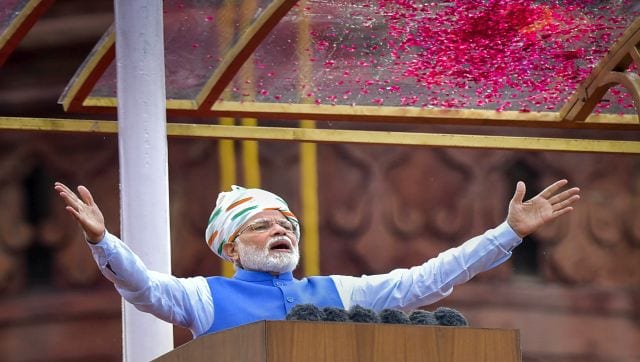 In 2022, Prime Minister Narendra Modi laid down the five resolves or the ‘panch pran’ for the ‘Amrit Kaal’ during his Independence Day speech. File image/PTI[/caption] Coronavirus and ‘Make for the World’ (2020) This was the year that the world had seen lockdowns owing to the coronavirus. Amid several health measures, PM Modi gave the mantra of ‘Make for the World’. He said the country must not only ‘Make in India’ but also ‘Make for the World’. He added that the country had moved from just making N-95 masks, PPE and ventilators to exporting these items to other countries. He also announced the launch of the National Digital Health Mission under which every Indian is to get a unique health ID. The mindset of free India should be ‘vocal for local’, and that the country must appreciate its local products, he said. New laws and new mindset (2019) Returning to power in 2019 for his second term, PM Modi made a push for abrogation of Article 370 and 35A, saying it was a significant step towards fulfilling the dream of Sardar Vallabh Bhai Patel and added that the spirit of “One Nation, One Constitution” has become a reality. He also highlighted that his administration had done away with almost 1, 450 obsolete laws. It was the year that PM Modi also announced the creation of the Chief of Defence Staff, a landmark in the defence sector. While making this announcement, he had said that it would sharpen coordination between the Armed Forces.
In 2022, Prime Minister Narendra Modi laid down the five resolves or the ‘panch pran’ for the ‘Amrit Kaal’ during his Independence Day speech. File image/PTI[/caption] Coronavirus and ‘Make for the World’ (2020) This was the year that the world had seen lockdowns owing to the coronavirus. Amid several health measures, PM Modi gave the mantra of ‘Make for the World’. He said the country must not only ‘Make in India’ but also ‘Make for the World’. He added that the country had moved from just making N-95 masks, PPE and ventilators to exporting these items to other countries. He also announced the launch of the National Digital Health Mission under which every Indian is to get a unique health ID. The mindset of free India should be ‘vocal for local’, and that the country must appreciate its local products, he said. New laws and new mindset (2019) Returning to power in 2019 for his second term, PM Modi made a push for abrogation of Article 370 and 35A, saying it was a significant step towards fulfilling the dream of Sardar Vallabh Bhai Patel and added that the spirit of “One Nation, One Constitution” has become a reality. He also highlighted that his administration had done away with almost 1, 450 obsolete laws. It was the year that PM Modi also announced the creation of the Chief of Defence Staff, a landmark in the defence sector. While making this announcement, he had said that it would sharpen coordination between the Armed Forces.
Read our full coverage of Independence Day How the Red Fort became part of our Independence story Nuclear tests, liberalisation and more… The milestones that define India Why the Tricolour is hoisted on Independence Day but unfurled on Republic Day Prep for 6G in India is on, says PM Modi on I-Day. How different is it from 5G? Why is kite-flying such a big tradition on Independence Day? Vishwakarma Yojana and more… Schemes mentioned in PM Modi’s I-Day speech How ‘Jana Gana Mana’ was adopted as India’s national anthem
A recap of the Modi Sarkar (2018) As this was his last speech in his first tenure as prime minister, PM Modi used this chance to present the country with a report card of his government. The 2016 surgical strikes against terror launch pads were mentioned, as was GST, and his government’s work towards building toilets, electrification, and strengthening the Indian passport. He also announced the flagship health scheme, Ayushmann Bharat to provide health cover of up to Rs 5 lakh per family per year, and said it would be rolled out in September. During his 2018 Independence Day speech, PM Modi also declared the grant of Permanent Commission for the appointment of women officers in the Short Service Commission of Indian Armed Forces. Moreover, he also announced India’s “Gaganyaan” plan, a manned space mission, which is expected to take place in 2024. [caption id=“attachment_13000972” align=“alignnone” width=“640”]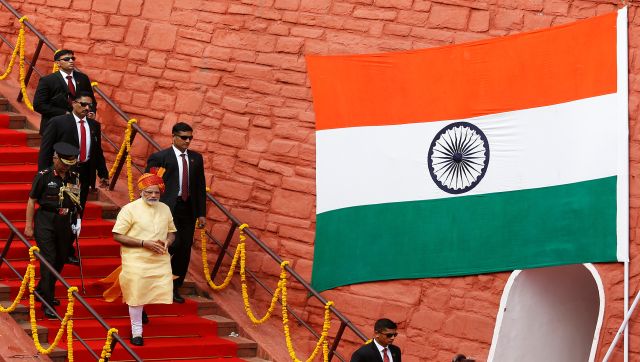 Prime Minister Narendra Modi leaves after addressing the nation from the Red Fort during Independence Day celebrations in Delhi, in 2017. File image/Reuters[/caption] Bharat Jodo (2017) PM Modi in this year, the 75th anniversary of the Quint India movement, said that while Quit India was about “Bharat Chhodo”, the call of today is “Bharat Jodo”. In his 56-minute long speech, his shortest one so far, he urged citizens to leave the ‘chalta hai’ (casual) attitude and think of ‘badal sakta hai’ (it can change). “This attitude will help us as a nation,” he said. He also mentioned the demonetisation initiative, and noted that Indians had shown patience and faith in its aftermath. A major focus of the 2017 speech for Modi was the confiscation of benami property, stating that government had not only confiscated black money worth Rs. 1.25 lakh crore but also cancelled the registration of 1.75 lakh companies out of three lakh dealing in hawala transactions. Attack on Pakistan (2016) Prime Minister Modi’s 2016 speech was different from his previous ones, as he took on Pakistan in it. Speaking about Balochistan for the first time, Modi had said: “For the past few days the people of Balochistan, the people of Gilgit, the people of Pakistan Occupied Kashmir, the way their citizens have heartily thanked me, the way they have acknowledged me, the goodwill they have shown towards me… [They] acknowledge the Prime Minister of India, they honour him, so it is an honour of my 125 crore countrymen, it is respect of my 125 crore countrymen… I want to heartily thank the people of Balochistan, the people of Gilgit, the people of Pakistan Occupied Kashmir.” ‘Start up India, Stand Up India’ (2015) In 2015, PM Modi coined the slogan ‘Start-up India, Stand up India’, aimed at extending support to people to start new ventures and businesses, especially those belonging to the weaker sections. It was also the year that the prime minister announced that the government had in principle, accepted the ‘One Rank One Pension’ demand from the Armed Forces. He also announced the ambitious Housing for All programme. [caption id=“attachment_13000952” align=“alignnone” width=“640”]
Prime Minister Narendra Modi leaves after addressing the nation from the Red Fort during Independence Day celebrations in Delhi, in 2017. File image/Reuters[/caption] Bharat Jodo (2017) PM Modi in this year, the 75th anniversary of the Quint India movement, said that while Quit India was about “Bharat Chhodo”, the call of today is “Bharat Jodo”. In his 56-minute long speech, his shortest one so far, he urged citizens to leave the ‘chalta hai’ (casual) attitude and think of ‘badal sakta hai’ (it can change). “This attitude will help us as a nation,” he said. He also mentioned the demonetisation initiative, and noted that Indians had shown patience and faith in its aftermath. A major focus of the 2017 speech for Modi was the confiscation of benami property, stating that government had not only confiscated black money worth Rs. 1.25 lakh crore but also cancelled the registration of 1.75 lakh companies out of three lakh dealing in hawala transactions. Attack on Pakistan (2016) Prime Minister Modi’s 2016 speech was different from his previous ones, as he took on Pakistan in it. Speaking about Balochistan for the first time, Modi had said: “For the past few days the people of Balochistan, the people of Gilgit, the people of Pakistan Occupied Kashmir, the way their citizens have heartily thanked me, the way they have acknowledged me, the goodwill they have shown towards me… [They] acknowledge the Prime Minister of India, they honour him, so it is an honour of my 125 crore countrymen, it is respect of my 125 crore countrymen… I want to heartily thank the people of Balochistan, the people of Gilgit, the people of Pakistan Occupied Kashmir.” ‘Start up India, Stand Up India’ (2015) In 2015, PM Modi coined the slogan ‘Start-up India, Stand up India’, aimed at extending support to people to start new ventures and businesses, especially those belonging to the weaker sections. It was also the year that the prime minister announced that the government had in principle, accepted the ‘One Rank One Pension’ demand from the Armed Forces. He also announced the ambitious Housing for All programme. [caption id=“attachment_13000952” align=“alignnone” width=“640”]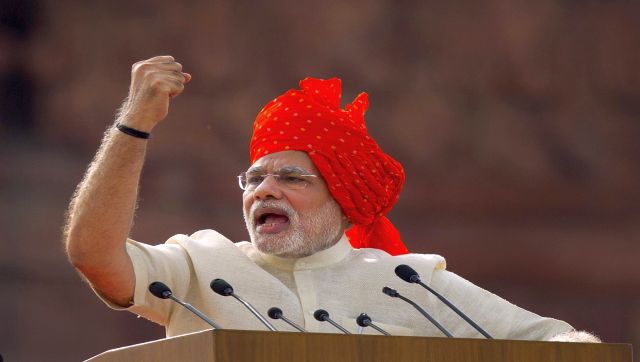 Prime Minister Narendra Modi addresses the nation on the country’s Independence Day in New Delhi. The year 2014 was PM Modi’s first address from the historic Red Fort. File image/PTI[/caption] Swachh Bharat (2014) Less than 100 days after Narendra Modi stormed to power and became prime minister that he walked up the ramparts of Red Fort and delivered his maiden Independence Day speech. It was in this year that Modi announced the Swachh Bharat and Jan Dhan Yojana as well as Skill India, which aimed at equipping people with skills for employability. In a speech that clocked 64 minutes, he also described himself as the ‘pradhan sevak’ of the country and spoke of taking everyone along. “I am an outsider to Delhi… I have been quite isolated from the elite class of this place, but during the last two months… I had an insider view, and I was astonished. It is not a political platform, rather it is a platform of a national policy and, therefore, my views should not be evaluated from a political perspective,” the PM had said. With inputs from agencies
Prime Minister Narendra Modi addresses the nation on the country’s Independence Day in New Delhi. The year 2014 was PM Modi’s first address from the historic Red Fort. File image/PTI[/caption] Swachh Bharat (2014) Less than 100 days after Narendra Modi stormed to power and became prime minister that he walked up the ramparts of Red Fort and delivered his maiden Independence Day speech. It was in this year that Modi announced the Swachh Bharat and Jan Dhan Yojana as well as Skill India, which aimed at equipping people with skills for employability. In a speech that clocked 64 minutes, he also described himself as the ‘pradhan sevak’ of the country and spoke of taking everyone along. “I am an outsider to Delhi… I have been quite isolated from the elite class of this place, but during the last two months… I had an insider view, and I was astonished. It is not a political platform, rather it is a platform of a national policy and, therefore, my views should not be evaluated from a political perspective,” the PM had said. With inputs from agencies
)